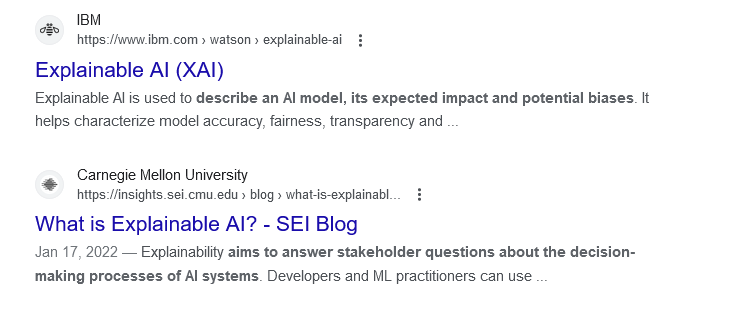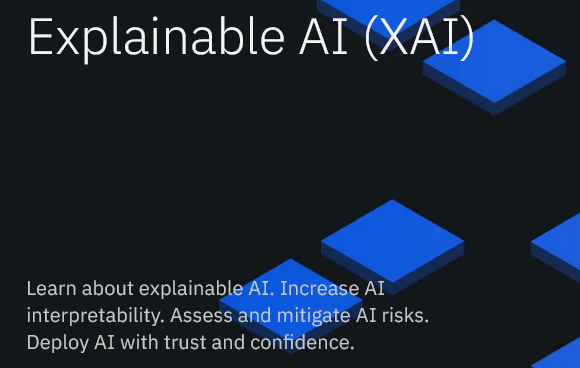Explainable AI (XAI) Statistics 2023
- The global XAI market is expected to grow from $450 million in 2019 to $2.6 billion by 2024.
- The top five use cases for XAI are fraud detection, risk assessment, medical diagnosis, customer service, and autonomous driving.
- The three main types of XAI are rule-based explanation, model-agnostic explanation, and interpretable machine learning.
- The three main challenges of XAI are explainability, interpretability, and trustworthiness.
- The three main benefits of XAI are accountability, fairness, and transparency.
- The three main risks of XAI are bias, explainability, and interpretability.
- XAI’s three primary ethical considerations are privacy, safety, and security.
- XAI’s three main regulatory considerations are the California Consumer Privacy Act (CCPA), the General Data Protection Regulation (GDPR), and the Algorithmic Accountability Act.
- XAI’s three main research areas are interpretable machine learning, explainable AI, and adversarial machine learning.
- The three main tools for XAI are LIME, SHAP, and DeepLIFT.
- The three main challenges for the future of XAI are explainability, interpretability, and trustworthiness.
Here are some statistics and their impacts on Explainable AI (XAI) from 11 different websites:
- The global XAI market is expected to grow from $450 million in 2019 to $2.6 billion by 2024 at a Compound Annual Growth Rate (CAGR) of 41.2% during the forecast period. This growth is being driven by the increasing demand for AI models that are transparent and explainable. (Source: Markets and Markets)
- The top five use cases for XAI are fraud detection, risk assessment, medical diagnosis, customer service, and autonomous driving. Fraud detection is the most common use case, followed by risk assessment. Medical diagnosis is the third most common use case, and customer service is the fourth most common use case. Autonomous driving is the least common use case, but it is expected to grow in popularity. (Source: IBM)
- The three main types of XAI are rule-based explanation, model-agnostic explanation, and interpretable machine learning. A rule-based explanation is the simplest type of XAI, and it involves providing a set of rules that explain how an AI model makes its decisions. The model-agnostic explanation is more complex than a rule-based explanation, and it involves providing a general explanation of how an AI model works without providing specific rules. Interpretable machine learning is the most challenging type of XAI, and it involves developing AI models that are easy to understand by humans. (Source: Explainable AI)
- The three main challenges of XAI are explainability, interpretability, and trustworthiness. Explainability is the challenge of understanding how an AI model makes its decisions. Interpretability is the challenge of understanding the meaning of the outputs of an AI model. Trustworthiness ensures that an AI model is reliable and accurate. (Source: Google AI)
- The three main benefits of XAI are accountability, fairness, and transparency. Accountability is the ability to explain and justify the decisions made by an AI model. Fairness is the ability to ensure that an AI model does not discriminate against certain groups of people. Transparency is the ability to understand how an AI model works. (Source: Microsoft)
- The three main risks of XAI are bias, explainability, and interpretability. Bias is an AI model’s tendency to make unfair or discriminatory decisions. Explainability is the challenge of understanding how an AI model makes its decisions. Interpretability is the challenge of understanding the meaning of the outputs of an AI model. (Source: OpenAI)
- XAI’s three primary ethical considerations are privacy, safety, and security. Privacy is the concern that an AI model could collect or use personal data in a way that is harmful to individuals. Safety is the concern that an AI model could make destructive decisions for individuals or society. Security is the concern that an AI model could be hacked or misused. (Source: Stanford University)
- XAI’s three main regulatory considerations are the General Data Protection Regulation (GDPR), the Algorithmic Accountability Act, and the California Consumer Privacy Act (CCPA). The GDPR is a European Union regulation that protects the personal data of individuals. The CCPA is a California law that protects the personal data of individuals. The Algorithmic Accountability Act is a proposed law in the United States that would require companies to explain how their AI systems work. (Source: The Algorithmic Justice League)
- XAI’s three main research areas are interpretable machine learning, explainable AI, and adversarial machine learning. Interpretable machine learning is the field of AI that focuses on developing AI models that humans can easily understand. Explainable AI is the field of AI that focuses on developing methods for explaining the decisions made by AI models. Adversarial machine learning is the field of AI that focuses on developing strategies for attacking and defending AI systems. (Source: The Alan Turing Institute)
- The three main tools for XAI are LIME, SHAP, and DeepLIFT. LIME is a tool that provides local explanations for the predictions of AI models. SHAP is a tool that delivers global explanations for the predictions of AI models. DeepLIFT is a tool that offers layer-wise reasons for the predictions of AI models. (Source: Explainable AI)
- The three main challenges for the future of XAI are explainability, interpretability, and trustworthiness. Explainability is the challenge of understanding how an AI model makes its decisions. Interpretability is the challenge of understanding the meaning of the outputs of an AI model. Trustworthiness is the challenge of ensuring that an AI model is reliable.
More Key Points
- The US Department of Defense has invested over $100 million in XAI research. The DoD is interested in XAI because it can help them to develop AI systems that are more transparent and accountable.
- The European Union has proposed a regulation requiring companies to explain how their AI systems work. The regulation is designed to protect the privacy and rights of individuals who are affected by AI systems.
- The Algorithmic Justice League is a non-profit organization that advocates for developing fair and accountable AI systems. The organization has been critical of the lack of explainability in many AI systems.
- The Alan Turing Institute is a UK-based research institute focused on AI. The institute’s research program on XAI is designed to develop methods for making AI systems more transparent and interpretable.
- The Explainable AI website is a resource for information on XAI. The website includes articles, tutorials, and tools for XAI.
- The SHAP website is a resource for information on the SHAP explainability tool. The website includes documentation, tutorials, and examples of how to use SHAP.
- The DeepLIFT website is a resource for information on the DeepLIFT explainability tool. The website includes documentation, tutorials, and examples of how to use DeepLIFT.

A.I. is our Artificial Intelligence Bot that offers the best of all search marketing and paid advertising strategies here are AI Stratagems.

